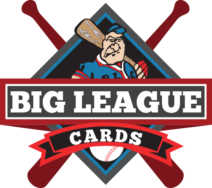How Do I Take Care of My Baseball Cards?
So I was talking last week with my good friend Vito from the neighborhood (not to be in the least bit confused with Jenny from the Block). Vito was regaling me with tales of how when he was a youngster, he and his friends used to take their cards and “flip” them. This involved taking one’s beloved Gil Hodges card and tossing it against a wall, attempting to get it to land closer than your friends’ cards. It’s almost cringe-worthy now to hear this, but Vito and his pals were not alone. Few could have guessed that decades later, these dinged, creased and damaged pieces of cardboard could have been worth thousands more had they been properly preserved.
Fast forward to today, and I’m still surprised to learn that so many people have not learned to treat their cards better. I’m often in my favorite hobby shop when inevitably someone will come in thinking that they may be sitting on a small fortune’s worth of cardboard gold. Yet, despite the optimism expressed towards their potential windfall, they come in with their 60 year old cards wrapped in rubber bands or loose in a shoe-box. Card abuse is a serious problem, folks. I would have thought that it would be common sense for most people who are attempting to sell anything that keeping that item in the best possible condition would be of paramount importance. However, through interacting with many of these people, I began to realize that unless you are highly familiar with the hobby, just how to protect these items from damage is not common knowledge.
While many of my long time readers will already be familiar with this information, hopefully this article will contain some helpful and edifying tips for those new to the hobby. The first thing that all collectors should keep in mind at all times is that condition is king. Many vintage cards have still managed to retain their value despite lifetimes of abuse via handling, storage or even “flipping”. However, their ability to fetch top dollars tends to increase exponentially according to how well they have been preserved. As an extreme example, that 1952 Mickey Mantle card your grandfather passed down to you might still garner you a few thousand dollars on eBay despite its poor condition, but one that was professionally graded a mint 9 (out of 10) recently sold at auction for $2.88 million. This, of course, is an extreme example. However, the difference between your 2018 Ronald Acuna, Jr. card selling for $25 or $0.25 may very well come down to condition. Okay, so now that we’ve established that, what is one to do?
While there are several options available to you, I will be highlighting just a few of the basic ones. Most of the supplies I will be describing here are available at almost any reputable card shop. If you don’t live near a hobby shop, they can also be purchased online from any number of sites.
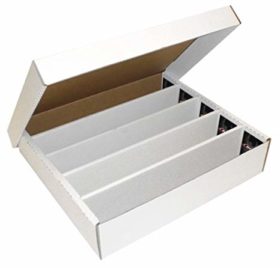 Step #1, which I would highly recommend to everyone, would be to ditch that old shoebox, or worse yet Ziploc bag, you may have been storing your cards in and buy a card storage box or boxes for your collection. These come in all kinds of sizes from a small box able to hold 100 cards to a five row “monster box” (about the size of a large pizza box) which can accommodate up to 5000 regular sized cards. These boxes are highly affordable with even the largest only costing less than $5. The boxes are made to the height and width of the average trading card meaning that you don’t have to worry as much about them shifting around inside every time you move the box. You can easily sort the cards within numerically, by year, by team or however you chose to and have easy access to them.
Step #1, which I would highly recommend to everyone, would be to ditch that old shoebox, or worse yet Ziploc bag, you may have been storing your cards in and buy a card storage box or boxes for your collection. These come in all kinds of sizes from a small box able to hold 100 cards to a five row “monster box” (about the size of a large pizza box) which can accommodate up to 5000 regular sized cards. These boxes are highly affordable with even the largest only costing less than $5. The boxes are made to the height and width of the average trading card meaning that you don’t have to worry as much about them shifting around inside every time you move the box. You can easily sort the cards within numerically, by year, by team or however you chose to and have easy access to them.
For those cards which you wish to display or look at more often, there are available nine pocket pages of soft clear plastic. Each pocket can hold one card with both the front and back displayed or two cards back to back. These pages come with holes pre-punched in the side so that they can be easily stored in binders. The pages usually cost about $0.20-$0.30 apiece, but you may be able to buy them for less in volume. These type pages have been around for 30+ years, however much improvement has been made in their quality over that time. Older pages were either made of hard and brittle plastic that would continually break when the pages were turned or of cheaper plastics that could easily melt in the heat. Today’s pages tend to be acid free and made of materials that will not damage your cards under normal conditions. As for binders, you can buy sports themed ones at your local hobby shop for under $10 which can usually accommodate more pages and are nicely padded on the outside. However, for those wishing to save money, any binder from the dollar store, or even your old 5th grade trapper keeper will suffice. Some people like to decorate the outside of their binders with something relative to the theme of the cards inside. For example, I have one binder full of players in their UCF collegiate uniforms and placed on the front a logo of their National Championship banner.
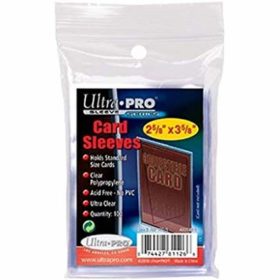
For those not wishing to place their cards unprotected in boxes or display them in binders, the first place to start is with soft clear plastic card sleeves, often referred to as “penny sleeves”. As the name implies, they are usually sold in packs of 100 for around $1. Your trading cards should easily slip inside these sleeves. These offer a minimal amount of protection for the cards, but are much better than handling them raw. Many collectors insist on sleeving all of their cards, but this can obviously become rather costly as your collection grows. My personal recommendation would be to take your better or most prized cards and both sleeve them and place them into what are called “toploaders”.
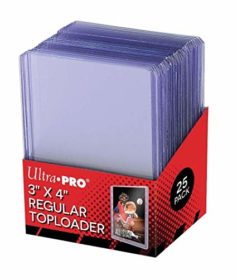 Toploaders are more rigid than penny sleeves and offer a great deal of protection from handling. These come in a variety of sizes from 35 point (for the standard sized card) on up to 360 point (for much thicker cards). For a few dollars, one can purchase a package of these. In the smaller sizes they come 25 to a pack, while many of the thicker sizes contain fewer. The cards you have already penny sleeved should slip right into these toploaders and can now be handled with much less fear of damage. If you’re not sure which size toploader is right for your cards, ask your local hobby shop employee who should be able to find the right fit for you.
Toploaders are more rigid than penny sleeves and offer a great deal of protection from handling. These come in a variety of sizes from 35 point (for the standard sized card) on up to 360 point (for much thicker cards). For a few dollars, one can purchase a package of these. In the smaller sizes they come 25 to a pack, while many of the thicker sizes contain fewer. The cards you have already penny sleeved should slip right into these toploaders and can now be handled with much less fear of damage. If you’re not sure which size toploader is right for your cards, ask your local hobby shop employee who should be able to find the right fit for you.
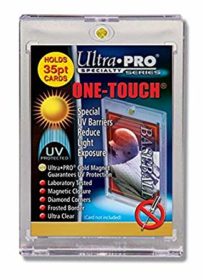 If you have any really nice or expensive cards that you want to buy the best protection for, there are also available magnetic cases, or “one-touches” as they are sometimes referred to. Also coming in a wide variety of thicknesses, these offer an even greater amount of protection. If you plan on selling some of your autographed or high end rookie cards on eBay, many buyers expect their cards to be shipped within a magnetic case. These cases are two piece Lucite holders which easily come apart to place the card inside and seal magnetically. Many of these also offer the added benefit of offering UV protection. Since these cases do come apart, and can be prone to scratching, it is also recommended that you buy a package of one-touch bags. These bags can be placed over the holders, are re-sealable and offer one more added layer of protection. These bags are also relatively inexpensive usually coming in 100 count packages for only a few dollars.
If you have any really nice or expensive cards that you want to buy the best protection for, there are also available magnetic cases, or “one-touches” as they are sometimes referred to. Also coming in a wide variety of thicknesses, these offer an even greater amount of protection. If you plan on selling some of your autographed or high end rookie cards on eBay, many buyers expect their cards to be shipped within a magnetic case. These cases are two piece Lucite holders which easily come apart to place the card inside and seal magnetically. Many of these also offer the added benefit of offering UV protection. Since these cases do come apart, and can be prone to scratching, it is also recommended that you buy a package of one-touch bags. These bags can be placed over the holders, are re-sealable and offer one more added layer of protection. These bags are also relatively inexpensive usually coming in 100 count packages for only a few dollars.
The next step up from magnetic cases is to have your cards professionally graded and encased by a leading authenticator. This can be very expensive depending on which cards you wish to have preserved. I will delve into how to go about doing this, for those interested, in a future column.
For now, I hope this provided a basic primer for those interested in taking better care of your favorite trading cards. You definitely have a lot of options at your disposal now to protect your collection much better than Vito’s friends did back in the day. Thanks for reading, and happy collecting.
-DF from Big League

